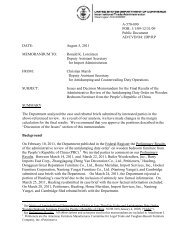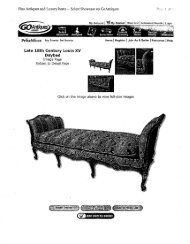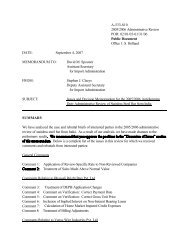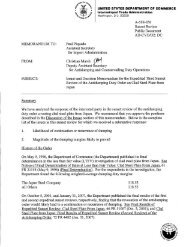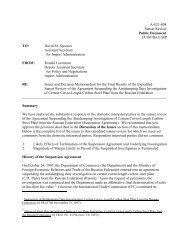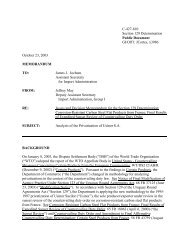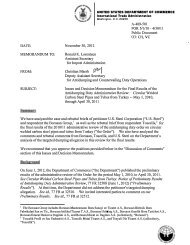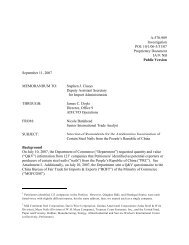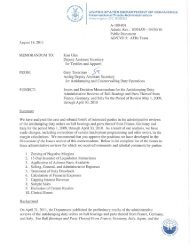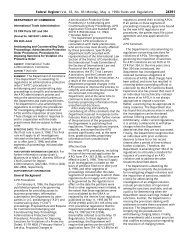Raw Flexible Magnets from China and Taiwan - Import ...
Raw Flexible Magnets from China and Taiwan - Import ...
Raw Flexible Magnets from China and Taiwan - Import ...
Create successful ePaper yourself
Turn your PDF publications into a flip-book with our unique Google optimized e-Paper software.
January 10, 2011<br />
MEMORANDUM TO: Christian Marsh<br />
Deputy Assistant Secretary<br />
for Antidumping <strong>and</strong> Countervailing Duty Operations<br />
FROM: Abdelali Elouaradia<br />
Office Director<br />
<strong>Import</strong> Administration, Office 4<br />
A-570-922<br />
C-570-923<br />
A-583-842<br />
Scope Inquiry<br />
Public Document<br />
IA/O4: TEM<br />
REGARDING: Antidumping <strong>and</strong> Countervailing Duty Orders on <strong>Raw</strong> <strong>Flexible</strong><br />
<strong>Magnets</strong> <strong>from</strong> the People’s Republic of <strong>China</strong> <strong>and</strong> Antidumping<br />
Duty Order on <strong>Raw</strong> <strong>Flexible</strong> <strong>Magnets</strong> <strong>from</strong> <strong>Taiwan</strong><br />
SUBJECT: Final Scope Ruling on Certain Retail Hook <strong>and</strong> Paper Towel<br />
<strong>Magnets</strong><br />
Summary<br />
On March 26, 2010, the Department of Commerce (“the Department”) received a scope ruling<br />
request <strong>from</strong> InterDesign Corp. (“InterDesign”) for a determination as to whether sixty hook <strong>and</strong><br />
paper towel magnet products are within the scope of the antidumping <strong>and</strong> countervailing duty<br />
orders on raw flexible magnets <strong>from</strong> the People’s Republic of <strong>China</strong> (“PRC”) <strong>and</strong> <strong>Taiwan</strong>. 1 The<br />
request contains descriptions <strong>and</strong> photographs of the magnets. Additionally, InterDesign Corp.<br />
submitted samples of the magnets. As described below, the InterDesigns hook <strong>and</strong> paper towel<br />
magnets subject to the scope inquiry are separated into five models based on their physical<br />
characteristics. On May 18, 2010, the Department initiated a formal scope inquiry, <strong>and</strong><br />
requested comments <strong>from</strong> the interested parties with respect to the criteria of 19 CFR<br />
351.225(k)(2). We received comments <strong>and</strong> rebuttal comments on June 9, 10, 17, <strong>and</strong> 21, 2010.<br />
On September 13, 2010, we extended the deadline for the Department’s final scope ruling to<br />
January 11, 2011.<br />
For the reasons described below, we have determined, through our review of the descriptions of<br />
the products contained in the antidumping <strong>and</strong> countervailing duty orders, that certain retail hook<br />
<strong>and</strong> paper towel magnets are outside of the scope of the <strong>Magnets</strong> Orders.<br />
1 See Letter <strong>from</strong> InterDesign Corp. to the Secretary of Commerce, “Scope Ruling Request regarding A-570-922, C-<br />
570-923 <strong>and</strong> A-583-842; <strong>Raw</strong> <strong>Flexible</strong> <strong>Magnets</strong> <strong>from</strong> the People’s Republic of <strong>China</strong> <strong>and</strong> <strong>Taiwan</strong>” (March 26,<br />
2010) (“Scope Ruling Request”).
Applicable Regulations<br />
The regulations governing the Department’s antidumping <strong>and</strong> countervailing duty scope<br />
determinations can be found at 19 CFR 351.225. On matters concerning the scope of an<br />
antidumping <strong>and</strong>/or countervailing duty order, our initial bases for determining whether a<br />
product is included within the scope of an order are the application for a scope ruling, <strong>and</strong> the<br />
descriptions of the product contained in the Petition, the initial investigation, <strong>and</strong> the prior<br />
determinations of the Secretary (such as prior scope rulings) <strong>and</strong> the International Trade<br />
Commission (“ITC”). 2<br />
Where the application for a scope ruling <strong>and</strong> the descriptions of the merch<strong>and</strong>ise contained in the<br />
Petition, the initial investigation, <strong>and</strong> the prior determinations of the Secretary <strong>and</strong> the ITC are<br />
not dispositive, the Department will initiate a formal scope inquiry <strong>and</strong> may consider the<br />
additional factors set forth at 19 CFR 351.225(k)(2). The determination as to which analytical<br />
framework is most appropriate in any given scope inquiry is made on a case-by-case basis after<br />
consideration of all record evidence before the Department.<br />
Scope Of The Orders<br />
The scope description as published in Antidumping Duty Order: <strong>Raw</strong> <strong>Flexible</strong> <strong>Magnets</strong> <strong>from</strong> the<br />
People's Republic of <strong>China</strong>, 73 FR 53847 (September 17, 2008); <strong>Raw</strong> <strong>Flexible</strong> <strong>Magnets</strong> <strong>from</strong> the<br />
People's Republic of <strong>China</strong>: Countervailing Duty Order, 73 FR 53849 (September 17, 2008);<br />
<strong>and</strong> Antidumping Duty Order: <strong>Raw</strong> <strong>Flexible</strong> <strong>Magnets</strong> <strong>from</strong> <strong>Taiwan</strong>, 73 FR 53848 (September<br />
17, 2008) (“<strong>Magnets</strong> Orders”) is as follows:<br />
The products covered by this order are certain flexible magnets regardless of<br />
shape, 3 color, or packaging. 4 Subject flexible magnets are bonded magnets<br />
composed (not necessarily exclusively) of (i) any one or combination of various<br />
flexible binders (such as polymers or co-polymers, or rubber) <strong>and</strong> (ii) a magnetic<br />
element, which may consist of a ferrite permanent magnet material (commonly,<br />
strontium or barium ferrite, or a combination of the two), a metal alloy (such as<br />
NdFeB or Alnico), any combination of the foregoing with each other or any other<br />
material, or any other material capable of being permanently magnetized.<br />
Subject flexible magnets may be in either magnetized or unmagnetized (including<br />
demagnetized) condition, <strong>and</strong> may or may not be fully or partially laminated or<br />
fully or partially bonded with paper, plastic, or other material, of any composition<br />
<strong>and</strong>/or color. Subject flexible magnets may be uncoated or may be coated with an<br />
adhesive or any other coating or combination of coatings.<br />
2<br />
See 19 CFR 351.225(d) <strong>and</strong> 351.225 (k)(1).<br />
3<br />
The term “shape” includes, but is not limited to profiles, which are flexible magnets with a non-rectangular crosssection.<br />
4<br />
Packaging includes retail or specialty packaging such as digital printer cartridges.<br />
2
Specifically excluded <strong>from</strong> the scope of this order are printed flexible magnets,<br />
defined as flexible magnets (including individual magnets) that are laminated or<br />
bonded with paper, plastic, or other material if such paper, plastic, or other<br />
material bears printed text <strong>and</strong>/or images, including but not limited to business<br />
cards, calendars, poetry, sports event schedules, business promotions, decorative<br />
motifs, <strong>and</strong> the like. This exclusion does not apply to such printed flexible<br />
magnets if the printing concerned consists of only the following: a trade mark or<br />
trade name; country of origin; border, stripes, or lines; any printing that is<br />
removed in the course of cutting <strong>and</strong>/or printing magnets for retail sale or other<br />
disposition <strong>from</strong> the flexible magnet; manufacturing or use instructions (e.g.,<br />
“print this side up,” “this side up,” “laminate here”); printing on adhesive backing<br />
(that is, material to be removed in order to expose adhesive for use such as<br />
application of laminate) or on any other covering that is removed <strong>from</strong> the<br />
flexible magnet prior or subsequent to final printing <strong>and</strong> before use; nonpermanent<br />
printing (that is, printing in a medium that facilitates easy removal,<br />
permitting the flexible magnet to be re-printed); printing on the back (magnetic)<br />
side; or any combination of the above.<br />
All products meeting the physical description of subject merch<strong>and</strong>ise that are not<br />
specifically excluded are within the scope of this order. The products subject to<br />
the order are currently classifiable principally under subheadings 8505.19.10 <strong>and</strong><br />
8505.19.20 of the Harmonized Tariff Schedule of the United States (“HTSUS”).<br />
The HTSUS subheadings are provided only for convenience <strong>and</strong> customs<br />
purposes; the written description of the scope of the order is dispositive.<br />
Products Under Scope Inquiry<br />
All of InterDesign’s magnet products under consideration contain one of three types of ferrite<br />
magnets that are covered by the scope of the order. 5 The final products are sold in retail stores<br />
such as Ace Hardware <strong>and</strong> True Value. InterDesign’s Scope Ruling Request covers the<br />
following five models:<br />
(1) The first model covers five different InterDesign products called “Part #10101,” “Part<br />
#10206,” “Part #10250,” “Part #10260” <strong>and</strong> “Part #10101A0,” which use a ferrite magnet that is<br />
adhered to a round plastic housing. These products can be referred to as “round plastic<br />
magnets.”<br />
(2) The product called “York <strong>Magnets</strong>” consists of a ferrite magnet that is adhered to a ceramic<br />
or chrome housing <strong>and</strong> a chrome hook. Ceramic housings may or may not be printed with a<br />
trade name.<br />
5<br />
Each magnet at issue uses one of three types of ferrite magnets (1) high power small ferrite magnet with a<br />
composition of Nd2Fe14B; (2) normal magnets with a composition of BaFe12O19, SrFe12O19 or (3) rubber<br />
magnets with a composition of SrO6Fe2O3, CPE.<br />
3
(3) The product called “Targa <strong>Magnets</strong>” consists of ferrite magnets that are adhered to the two<br />
ends of a stainless steel or chrome housing that is attached to a flexible hose to enable its use as a<br />
paper towel holder.<br />
(4) The product called “Miro <strong>Magnets</strong>” consists of a ferrite magnet that is adhered to a plastic<br />
housing, which is attached to a plastic hook.<br />
(5) The product called “Forma <strong>Magnets</strong>” consists of a ferrite magnet that is adhered to a<br />
stainless steel housing <strong>and</strong> a hook. 6<br />
In addition to color photographs <strong>and</strong> schematic drawings in Exhibits “A” through “M” of<br />
InterDesign’s Scope Ruling Request, InterDesign provided product samples to the Department. 7<br />
Summary Of Arguments<br />
InterDesign<br />
• The products for which it now seeks a scope ruling are not “raw flexible magnets” <strong>and</strong>,<br />
rather, are a further finished product. Therefore, the products are not defined in the scope<br />
of the order. Its products are for final retail sale, <strong>and</strong> they require no furthering<br />
processing. 8 The flexible magnet allows the finished product to be hung on a household<br />
appliance or other metal object. The ITC, in its final injury analysis, provided a<br />
description of the domestic like product that is dissimilar <strong>from</strong> InterDesign’s products.<br />
The ITC stated that “(f)lexible magnets are permanent magnets that can be twisted, bent,<br />
slit, punched, coiled, <strong>and</strong> otherwise molded into any shape without loss of magnetic<br />
properties.” Also, the ITC stated that “raw flexible magnets consist of sheet (or<br />
sheeting), strip, <strong>and</strong> thermoplastic profile shapes, typically of uniform thickness <strong>and</strong><br />
surface finish.” 9<br />
• The ITC description suggests that the products covered by the scope of the order are raw<br />
magnets that can be modified or further processed. By contrast, InterDesign’s magnets<br />
are finished products that would be destroyed if twisted, bent, slit, punched, coiled, <strong>and</strong><br />
otherwise molded into any shape.<br />
• InterDesign also requested a tariff classification ruling <strong>from</strong> U.S. Customs <strong>and</strong> Border<br />
Protection (“CBP”). CBP found that the magnets give the InterDesign products their<br />
“essential character,” 10 <strong>and</strong> are thus correctly classified as magnets.<br />
6<br />
See Scope Ruling Request at 5-9.<br />
7<br />
The Department has retained InterDesign’s product samples. See Memor<strong>and</strong>um <strong>from</strong> Thomas Martin to the File,<br />
“InterDesign Corp. Product Samples,” dated May 4, 2010.<br />
8<br />
See Scope Ruling Request at 2.<br />
9<br />
See <strong>Raw</strong> <strong>Flexible</strong> <strong>Magnets</strong> <strong>from</strong> <strong>China</strong> <strong>and</strong> <strong>Taiwan</strong>, Investigation Nos. 701-TA-452 (Final) <strong>and</strong> 731-TA-1129-<br />
1130 (Final), Pub. No. 4030 (August 2008) at I-7-I-9.<br />
10<br />
The term “essential character” is a term of art used in the General Rules of Interpretation of the Harmonized Tariff<br />
Schedule of the United States.<br />
4
Petitioner Magnum Magnetics Corporation (“Magnum”)<br />
• All products <strong>from</strong> InterDesign are within the scope of the <strong>Magnets</strong> Orders, <strong>and</strong> are not a<br />
part of the printed text or images exclusion noted in the second paragraph of the scope. 11<br />
The <strong>Magnets</strong> Orders applies to “all flexible magnets without regard to shape, color,<br />
packaging, or magnetization; or to lamination or bonding of the magnets to any material<br />
of any composition.” 12 InterDesign’s products are clearly described by the <strong>Magnets</strong><br />
Orders in chemical composition <strong>and</strong> bonding. Additionally, all of the products subject to<br />
the scope inquiry do not meet the exclusion requirement of bearing printed text <strong>and</strong>/or<br />
images. 13 The Department made a determination in the “It’s Academic Scope Ruling,”<br />
where the Department found that flexible magnets that were bonded to plastic or other<br />
materials <strong>and</strong> were not printed, were subject to the order. 14<br />
• InterDesign’s argument that its products should be excluded <strong>from</strong> the scope because they<br />
are meant for final retail sale at mass retailers <strong>and</strong> specialty stores does not exclude the<br />
products <strong>from</strong> the <strong>Magnets</strong> Orders. The Department made a previous determination in<br />
the “Target Scope Ruling” 15 that retail packaging <strong>and</strong> the product’s intended end-use are<br />
not bases for exclusion. 16 Also citing the “Target Scope Ruling,” Magnum argues that<br />
the Department has determined that there is no distinction in the language between<br />
finished products <strong>and</strong> raw materials in the <strong>Magnets</strong> Orders <strong>and</strong>, therefore, this is not a<br />
basis for exclusion <strong>from</strong> the orders. 17<br />
• Finally, Magnum states that the products under consideration are classified under the<br />
U.S. Harmonized Tariff Schedule (“HTSUS”) subheading that establishes its “essential<br />
character.” Specifically, HTSUS subheading 8505.19 describes the products as<br />
“composite goods containing flexible magnets.” The proper HTSUS classification for all<br />
of InterDesign’s products under consideration indicates that these products are essentially<br />
flexible magnets, despite being bonded to other materials. 18<br />
On May 18, 2010, the Department initiated a formal scope inquiry <strong>and</strong> solicited further<br />
comments <strong>from</strong> InterDesign <strong>and</strong> Magnum. The interested parties’ further arguments were as<br />
follows:<br />
11<br />
See Letter <strong>from</strong> Magnum Magnetics Corporation to the Secretary of Commerce, “<strong>Raw</strong> <strong>Flexible</strong> <strong>Magnets</strong> <strong>from</strong> the<br />
People’s Republic of <strong>China</strong> <strong>and</strong> <strong>Taiwan</strong>: Comments on Scope Ruling Request By InterDesign Corp.” (April 23,<br />
2010) (“Petitioner Comments”) at 2.<br />
12<br />
Id. at 4; see also <strong>Magnets</strong> Orders at paragraph 1.<br />
13<br />
See Petitioner Comments at 3.<br />
14<br />
Id. at 4; See also Memor<strong>and</strong>um <strong>from</strong> Laurie Parkhill, Office Director, to John M. Andersen, Acting Deputy<br />
Assistant Secretary, “<strong>Raw</strong> <strong>Flexible</strong> <strong>Magnets</strong> <strong>from</strong> the People’s Republic of <strong>China</strong>; Scope Request <strong>from</strong> It’s<br />
Academic – Result of Inquiry – Final Determination in Part,” dated July 13, 2009 (“It’s Academic Scope Ruling”).<br />
15<br />
See Memor<strong>and</strong>um <strong>from</strong> Abdelali Elouaradia, Office Director, to John M. Andersen, Acting Deputy Assistant<br />
Secretary, “Final Scope Ruling on Certain Decorative Retail <strong>Magnets</strong>,” December 22, 2008 (“Target Scope<br />
Ruling”).<br />
16<br />
See Petitioner Comments at 6.<br />
17<br />
Id. at 6-7.<br />
18<br />
See Petitioner Comments at 7-8.<br />
5
InterDesign<br />
• The magnets it uses are not considered functionally flexible, as described in the <strong>Magnets</strong><br />
Orders. Although the hook <strong>and</strong> paper towel holder have flexible magnets attached, the<br />
magnets cannot be manipulated without damaging the product, (i.e., the portion which is<br />
not a magnet). 19<br />
• The hook <strong>and</strong> paper towel holder are finished products packaged for retail sale, so<br />
InterDesign is not manufacturing flexible magnets in forms that can be further machined.<br />
InterDesign adds that its products are not produced by extrusion or calendaring.<br />
• The manufacturing process places its products out of the scope. Its magnets have<br />
undergone “substantial transformation” as defined in 19 CFR 10.14(b), so that they are<br />
no longer considered magnets. 20 InterDesign also argues that the magnet is an<br />
insignificant component of the final product by material cost <strong>and</strong> net weight.<br />
• Its magnets are purchased by its vendor <strong>from</strong> another vendor. Purchasing the magnet<br />
<strong>from</strong> a third party adds additional cost to the InterDesign hook <strong>and</strong> towel holder. 21<br />
• The application of the <strong>Magnets</strong> Orders is erratic due to inconsistent HTS number<br />
assignments for products containing magnets. 22 InterDesign claims to have imported<br />
similar products.<br />
• Its hooks <strong>and</strong> paper towel holder are designed for use as household articles, <strong>and</strong> thus have<br />
different ultimate uses than the in-scope flexible magnets. 23 Unlike flexible magnets, the<br />
hook <strong>and</strong> towel holder feature stronger holding capacities <strong>and</strong> are not designed to be<br />
adapted to various uses.<br />
• It advertises its magnetic products differently <strong>from</strong> the producers of in-scope magnets,<br />
which are marketed to purchasers who intend to re-work the magnets. 24 Further, its<br />
hooks <strong>and</strong> towel holder are advertised to retailers that sell directly to the end user, thereby<br />
differentiating the products <strong>from</strong> other in-scope magnets.<br />
• Finally, the function <strong>and</strong> visual aspect of the item attached to the magnet are reasons for<br />
ultimate purchasers to buy the product; the role of the magnet is insignificant. 25<br />
19 See Letter <strong>from</strong> InterDesign to the Secretary of Commerce, dated June 9, 2010 (“InterDesign Comments”), at 6.<br />
20 Id. at 7.<br />
21 Id. at 8.<br />
22 Id.<br />
23 Id. at 10.<br />
24 See InterDesign Comments, at 10.<br />
25 Id. at 11.<br />
6
Petitioner<br />
• The language of the <strong>Magnets</strong> Orders is dispositive with respect to InterDesign’s magnetic<br />
products. Magnum cites to the Department’s ruling on “magnetic photo pockets” 26 <strong>and</strong><br />
explains that the <strong>Magnets</strong> Orders clearly apply to raw flexible magnets without regard to<br />
shape, color, packaging, magnetization, lamination, or bonding to other materials. 27 In<br />
addition, the scope clearly does not exclude products based on end-use, packaging, or<br />
degree of “advancement”. 28<br />
• InterDesign recognizes that its products contain flexible magnets, as indicated by the<br />
flexible magnets HTSUS classification for its products. 29<br />
• The magnetic hook <strong>and</strong> towel holder would be useless without their magnetic properties,<br />
thereby making them essentially flexible magnets. 30<br />
• Magnum rebuts InterDesign’s argument that it is importing finished goods, stating that<br />
the scope language does not differentiate between raw materials <strong>and</strong> finished goods. 31<br />
• InterDesign’s products share the same channels of trade <strong>and</strong> advertising as other in-scope<br />
magnets. 32 Magnum also notes that the scope explicitly covers magnets packaged for<br />
retail sale.<br />
InterDesign Rebuttal Comments<br />
• The scope of the <strong>Magnets</strong> Orders applies to flexible magnets, but not to products that<br />
incorporate magnets. 33 Its hook <strong>and</strong> towel holder should be out of scope, since its<br />
products are not mere flexible magnets, but products that feature magnets as part of their<br />
composition.<br />
• In response to Magnum’s claim that InterDesign’s products are in-scope regardless of the<br />
material bonded to the magnets, 34 InterDesign states that “bonding” is a stage in a<br />
flexible magnet’s production process rather than the production of a commercial item<br />
26<br />
See <strong>Raw</strong> <strong>Flexible</strong> <strong>Magnets</strong> <strong>from</strong> the People’s Republic of <strong>China</strong>: Final Affirmative Countervailing Duty<br />
Determination, 73 FR 39667 (July 10, 2008) <strong>and</strong> the accompanying Issues <strong>and</strong> Decision Memor<strong>and</strong>um at II. Scope<br />
Comments (“Final CVD Determination”).<br />
27<br />
See Letter <strong>from</strong> Petitioner to the Secretary of Commerce, dated June 10, 2010 (“Petitioner’s Post Initiation<br />
Comments”), at 3.<br />
28<br />
Id. at 6.<br />
29<br />
Id. at 8.<br />
30<br />
Id. at 9.<br />
31<br />
Id. at 10.<br />
32<br />
Id. at 12.<br />
33<br />
See Letter <strong>from</strong> InterDesign to the Secretary of Commerce, dated June 17, 2010 (“InterDesign Rebuttal”), at 5.<br />
34<br />
See Petitioner’s Post Initiation Comments, at 3.<br />
7
incorporating such a magnet. 35 Its production process does not include “bonding,” which<br />
is the point when a magnet becomes subject to the <strong>Magnets</strong> Orders. 36<br />
• InterDesign rejects Magnum’s claim that the product’s further advancement is irrelevant<br />
to the scope inquiry. Its products do not share in-scope magnets’ physical characteristics,<br />
such as thinness, flexibility, lightness of weight, <strong>and</strong> ease of cutting. 37<br />
• Purchasers of its hooks <strong>and</strong> towel holder expect to use them as such, while purchasers of<br />
flexible magnets intend to further work them. 38 Furthermore, flexible magnets are<br />
magnetically weaker than its products, demonstrating that its products are designed for a<br />
different purpose. 39<br />
• Its products are out of scope based on its channels of trade. While flexible magnets are<br />
mainly sold to distributors <strong>and</strong> wholesalers for resale, hooks <strong>and</strong> towel holders are sold to<br />
retailers. 40 Additionally, a consumer who sought a hook <strong>and</strong> towel holder would not<br />
secure supply <strong>from</strong> the distributors of magnetic magnets. 41<br />
• InterDesign reiterates that the magnets incorporated into its products compose 11% of<br />
material costs, <strong>and</strong> less than 4% of product weight. 42<br />
• Magnum’s statement of the products covered by the scope is misleadingly broad. 43<br />
Petitioner Rebuttal Comments<br />
• InterDesign bases its argument on an outdated version of the scope language. 44 The latest<br />
language applies to non-printed flexible magnets regardless of shape, color, packaging,<br />
magnetization, lamination, or bonding to other materials. 45 Further, the bonding of hard<br />
material to the magnet does not remove it <strong>from</strong> the scope of the <strong>Magnets</strong> Orders, so even<br />
if the products cannot be twisted or bent without damaging them, they are within the<br />
scope. 46<br />
35<br />
See InterDesign Rebuttal, at 6.<br />
36<br />
Id.<br />
37<br />
Id. at 8.<br />
38<br />
Id.<br />
39<br />
Id. at 9.<br />
40<br />
Id.<br />
41<br />
Id. at 11.<br />
42<br />
Id. at 10.<br />
43<br />
Id. at 12.<br />
44<br />
See Letter <strong>from</strong> Petitioner to the Secretary of Commerce, dated June 21, 2010 at 2.<br />
45 Id. at 3.<br />
46 Id. at 4.<br />
8
• InterDesign, in its comments, recognizes that its hooks <strong>and</strong> paper towel holder feature<br />
flexible magnets. 47<br />
• InterDesign’s use of CBP’s “substantial transformation” analysis is irrelevant in<br />
determining whether the products are in-scope. 48<br />
• Magnum rebuts InterDesign’s argument that the hooks <strong>and</strong> paper towel holders are out of<br />
scope because they are sold through retail outlets <strong>and</strong> used as household items, since inscope<br />
magnets are generally the same. 49<br />
• Channels of trade <strong>and</strong> advertisement are not criteria that sufficiently distinguish the hooks<br />
<strong>and</strong> towel holder <strong>from</strong> other in-scope magnets because in-scope magnets are sold through<br />
retailers <strong>and</strong> because the scope covers magnets packaged for retail sale. 50<br />
• Finally, Magnum rebuts InterDesign’s claim that the role of magnets in the hook <strong>and</strong><br />
paper towel holder is insignificant, since the descriptions of the end uses of its products<br />
state their primary uses are as magnets. 51<br />
Analysis<br />
In discussing the interpretive process the Department should follow in making scope rulings<br />
pursuant to 19 CFR 351.225(k)(1), the Court of Appeals for the Federal Circuit (“CAFC”) stated:<br />
The critical question is not whether the petition covered the merch<strong>and</strong>ise or<br />
whether it was at some point within the scope of the investigation. The purpose<br />
of the petition is to propose an investigation ... A purpose of the investigation is to<br />
determine what merch<strong>and</strong>ise should be included in the final order. Commerce’s<br />
final determination reflects the decision that has been made as to which<br />
merch<strong>and</strong>ise is within the final scope of the investigation <strong>and</strong> is subject to the<br />
order. Thus, the question is whether the {final scope of the order} included the<br />
subject merch<strong>and</strong>ise. 52<br />
The CAFC also commented that “a predicate for the interpretative process {in a scope inquiry} is<br />
language in the order that is subject to interpretation.” 53 Through these statements, the CAFC<br />
found that the appropriate place to begin the analysis as to whether a product is within the scope<br />
of an antidumping or countervailing duty order is to review the scope language of the<br />
antidumping duty order itself. Furthermore, the CAFC stated that “{s}cope orders may be<br />
47<br />
Id.<br />
48<br />
Id. at 5.<br />
49<br />
Id. at 7.<br />
50<br />
Id. at 7-8.<br />
51<br />
Id. at 8.<br />
52<br />
See Duferco Steel, Inc. v. United States, 296 F.3d 1087, 1096 (Fed. Cir. 2002) (“Duferco”) (emphasis Added).<br />
53<br />
Id. at 1097.<br />
9
interpreted as including subject merch<strong>and</strong>ise only if they contain language that specifically<br />
includes the subject merch<strong>and</strong>ise or may be reasonably interpreted to include it.” 54<br />
In accordance with Duferco, the Department must first examine the language of the scope of the<br />
<strong>Magnets</strong> Orders, including any exclusions, to determine whether InterDesign’s products are<br />
within the scope of the orders. Thus, the issue in this scope inquiry is whether InterDesign’s<br />
products are included or excluded based on the language of the <strong>Magnets</strong> Orders.<br />
Accordingly, the Department has referred to the language of the <strong>Magnets</strong> Orders to determine<br />
whether InterDesign’s magnet products are within or outside of the scope of the <strong>Magnets</strong> Orders.<br />
First, regarding InterDesign’s round plastic magnets, the type of housing to which the subject<br />
merch<strong>and</strong>ise is bonded is not functionally flexible, i.e., it cannot be manipulated without<br />
damaging the product. Second, with York <strong>Magnets</strong>, Miro <strong>Magnets</strong>, <strong>and</strong> Forma <strong>Magnets</strong>, devices<br />
such as metal or ceramic hooks bonded to a magnet render the product not to be functionally<br />
flexible, because they cannot be manipulated without damaging the product. 55 Third, for Targa<br />
<strong>Magnets</strong>, the paper towel holder’s chrome skirt mount is bonded to a magnet, rendering the<br />
product not to be functionally flexible, because it cannot be manipulated without damaging the<br />
product. The scope’s provision that raw flexible magnets can be bonded with “paper, plastic, or<br />
other material, of any composition” does not extend to the point that the material renders the<br />
flexible magnet to be no longer flexible. As the first sentence of the scope of the orders indicates<br />
that it pertains to flexible magnets, this suggests that magnets that have been rendered inflexible<br />
by attached materials should be outside the scope of the orders. Thus, the scope of the orders<br />
itself indicates that all five categories of InterDesign’s magnet products are outside of the scope.<br />
The scope language itself is dispositive of the Department’s determination that InterDesign’s<br />
products are outside of the scope of the <strong>Magnets</strong> Orders.<br />
The Department has not ruled previously that any products were either (1) outside of the scope of<br />
the orders due to an attachment that constrains flexibility; or (2) within the scope of the orders<br />
based upon any analysis, despite having attached materials that render the product inflexible. All<br />
products previously subject to scope inquiries that had attached materials were still manually<br />
flexible to some degree. For instance, in the investigation, the Department ruled that magnetic<br />
photo pockets were within the scope; however, the attached material in that instance was a thin<br />
layer of plastic. 56 In the Target Scope Ruling, we stated that the attached material was foam<br />
rubber, the flexibility of the products was not affected, <strong>and</strong> the Department found certain of the<br />
products to be both inside <strong>and</strong> outside the scope on other bases. 57 In a Memor<strong>and</strong>um <strong>from</strong><br />
54<br />
Id. at 1089 (emphasis added).<br />
55<br />
Record evidence also indicates that the York <strong>Magnets</strong> are printed with a trade name. See Scope Ruling Request at<br />
Exhibits A <strong>and</strong> B. Since the scope exclusion of printed magnets does not exclude printed trade names, the York<br />
<strong>Magnets</strong> printed with a trade name are not excluded <strong>from</strong> the orders based upon the printing.<br />
56<br />
“In its request, SH Industries acknowledges that its magnetic photo pockets consist of flexible magnet material<br />
with a layer of plastic laminate fused along the sides of the flexible magnet.” See Final CVD Determination <strong>and</strong> the<br />
accompanying Issues <strong>and</strong> Decision Memor<strong>and</strong>um at II. Scope Comments.<br />
57<br />
“These decorative motifs, Target insists, are created by permanently bonding a variety of decorative materials<br />
(e.g., inks, glitter, foam) to a flexible magnetic backing <strong>and</strong>, in many instances, cutting them into decorative shapes .<br />
. . In its request for a scope inquiry, Target states that the ‘Foam Words & Phrases’ magnets <strong>and</strong> the ‘Just Married’<br />
10
Laurie Parkhill to John M. Andersen, “<strong>Raw</strong> <strong>Flexible</strong> <strong>Magnets</strong> <strong>from</strong> the People’s Republic of<br />
<strong>China</strong>; Scope Request <strong>from</strong> It’s Academic – Result of Inquiry - Final Scope Determination in<br />
Part,” dated March 4, 2010 (“It’s Academic Scope Ruling II”), we stated that the products at<br />
issue were still flexible despite being attached to PVC, <strong>and</strong> ruled them to be within the scope of<br />
the orders. 58 In this instance, the five categories of InterDesign magnet products at issue are all<br />
attached to materials that are not flexible, <strong>and</strong> are thus outside the scope of the <strong>Magnets</strong> Orders.<br />
Based upon the above analysis <strong>and</strong> pursuant to Duferco, there is no need to examine other<br />
sources pursuant to 19 CFR 351.225(k)(1) or use the Diversified Products criteria of<br />
351.225(k)(2).<br />
Recommendation<br />
In accordance with 19 CFR 351.225(k) <strong>and</strong> Duferco, we have determined, through our review of<br />
the descriptions of the products contained in the antidumping <strong>and</strong> countervailing duty orders, that<br />
certain retail hook <strong>and</strong> paper towel magnets are outside of the scope of the <strong>Magnets</strong> Orders. If<br />
you agree, we will send a letter to interested parties enclosing this ruling <strong>and</strong> will notify U.S.<br />
Customs <strong>and</strong> Border Protection of our determination.<br />
___________ Agree ___________ Disagree<br />
___________________________<br />
Christian Marsh<br />
Deputy Assistant Secretary<br />
for Antidumping <strong>and</strong> Countervailing Duty Operations<br />
___________________________<br />
Date<br />
magnet set consist of foam material <strong>and</strong> paper, respectively, ‘permanently bonded to a flexible magnetic backing.’”<br />
See Target Scope Ruling at 6, 8.<br />
58<br />
“Therefore, the Department must determine whether the injection-molding of a multiple-layer, multiple-part form<br />
of colored, plasticized (bendable) PVC is a printed image <strong>and</strong>/or text.” (emphasis in original) See It’s Academic<br />
Scope Ruling II at 7.<br />
11



